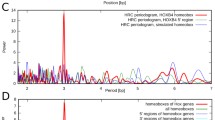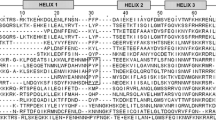Abstract
We report the isolation of nine rat cognates of mouse homeoboxes within the fourHox gene clusters and a rat homologue of mouseIPF1 homeobox,RHbox# 13A. The sequences of nine cloned homeoboxes are highly similar to those of the mouse and human homeoboxes in the Hox clusters. The restriction enzyme sites and map distances between each of the homeoboxes on the rat genome are nearly identical to those of mouse and human. Thus, we conclude that the isolated homeoboxes are the rat homologues of mouse homeoboxes within the four Hox clusters. A novel homeoboxRHbox# 13A is different from theDrosophila Antennapedia (Antp) sequence but is highly similar to theXlHbox8 (Xenopus laevis) andHtrA2 (Helobdella triserialis) homeoboxes. Forty-two amino acids of the last two-thirds of theRHbox# 13A, XlHbox8, and mouseIPF1 homeodomains completely matched. In addition, these four homeodomains contain a unique His residue in the recognition helix of a helix-turn-helix DNA-binding motif. This His residue is not found in any of the previously published mammalian homeodomain sequences except mouseIPF1.
Similar content being viewed by others
References
Acampora, D., D'Esposito, M., Faiella, A., Pannese, M., Migliaccio, E., Morelli, F., Stornaiuolo, A., Nigro, V., Simeone, A., and Boncinelli, E. (1989). The human HOX gene family.Nucl. Acids Res. 1710385.
Awgulewitsch, A., Bieberich, C., Bogarad, L., Shashikant, C., and Ruddle, F. H. (1990). Structural analysis ofHox-3.1 transcription unit and theHox-3.2-Hox-3.1 intergenic region.Proc. Natl. Acad. Sci. USA 876428.
Colberg-Poley, A. M., Voss, S. D., Chowdhury, K., Stewart, C. L., Wagner, E. F., and Gruss, P. (1985). Clustered homeo boxes are differentially expressed during murine development.Cell 4339.
Duboule, D., and Dollé, P. (1989). The murine Hox gene network: Its structural and functional organization resembles that ofDrosophila homeotic genes.EMBO J. 81497.
Falzon, M., and Chung, S. Y. (1988). The expression of rat homeobox-containing genes is developmentally regulated and tissue specific.Development 103601.
Falzon, M., Sanderson, N., and Chung, S. Y. (1987). Cloning and expression of rat homeoboxcontaining sequences.Gene 5423.
Gehring, W. J., Muller, M., Affolter, M., Percival-Smith, A., Billeter, M., Qian, Y. Q., Otting, G., and Wuthrich, K. (1990). The structure of the homeodomai and its functional implications.TIG 6323.
Graham, A., Papalopulu, N., and Krumlauf, R. (1989). The murine and Drosophila homeobox gene complexes have common features of organization and expression.Cell 57367.
Hart, C. P., Fainsod, A., and Ruddle, F. H. (1987). Sequence analysis of the murineHox-2.2, -2.3 and-2.4 homeo boxes: Evolutionary and structural comparisons.Genomics 1182.
Kessel, M., Schulze, F., Fibi, M., and Gruss, P. (1987). Primary structure and nuclear localization of a murine homeodomain protein.Proc. Natl. Acad. Sci. USA 845306.
Lonai, P., and Orr-Urtreger, A. (1990). Homeogenes in mammalian development and the evolution of cranium and central nervous system.FASEB 41436.
Lonai, P., Arman, E., Czosnek, H., Ruddle, F. H., and Blatt, C. (1987). New murine homeoboxes: Structure, chromosomal assignment and differential expression in adult erythropoiesis.DNA 6409.
McGinnis, W., Levine, M. S., Hafen, E., Kuroiwa, A., and Gehring, W. J. (1984a). A conserved DNA sequence in homeotic genes of theDrosophila Antennapedi a andBithorax complexes.Nature (London) 308428.
McGinnis, W., Garber, R. L., Wirz, J., Kuroiwa, A., and Gehring, W. J. (1984b). A homologous protein-coding sequence inDrosophila homeotic genes and its conservation in other metazoans.Cell 37403.
Odenwald, W. F., Taylor, C. F., Palmer-Hill, F. S., Friedrich, V., Tani, M., and Lazzarini, R. A. (1987). Expression of a homeodomain protein in non contact-inhibited cultured cells and postmitotic neurons.Genes Dev. 1482.
Ohlsson, H., Kajsa, K., and Edlund, T. (1993). IPF1, a homeodomain-containing transactivator of the insulin gene.EMBO J. 124251.
Sambrook, J., Fritsch, E. F., and Maniatis, T. (1989).Molecular Cloning: A Laboratory Manual Cold Spring Harbor Laboratory Press, Cold Spring Harbor, NY.
Sanger, F., Nicklen, S., and Coulson, A. R. (1977). DNA sequencing with chain-terminating inhibitors.Proc. Natl. Acad. Sci. USA 745463.
Scott, M. P. (1992). Vertebrate homeobox gene nomenclature.Cell 71551.
Scott, M. P., and Weiner, A. J. (1984). Structural relationships among genes that control development: Sequence homology between theAntennapedia, Ultra bithorax andfushi tarazu loci ofDrosophila.Proc. Natl. Acad. Sci. USA 814115.
Scott, M. P., Tamkun, J. W., and Hartzell, G. W., III (1989). The structure and function of the homeodomain.BBA Rev. Cancer 98925.
Wedeen, C. J., Kostriken, R. G., Matsumura, I., and Weisblat, D. A. (1990). Evidence for a new family of evolutionarily conseved homeobox genes.Nucl. Acids Res. 181908.
Wolgemuth, D. J., Engelmyer, E., Duggal, R. N., Gizang-Ginsberg, E., Mutter, G. L., Ponzetto, C., Viviano, C., and Zakeri, Z. F. (1986). Isolation of a mouse cDNA coding for a developmentally regulated, testis-specific transcript containing homeobox homology.EMBO J. 51229.
Wright, C. V. E., Schnegelsberg, P., and De Robertis, E. M. (1988).XlHbox8: A novelXenopus homeo protein restricted to a narrow band of endoderm.Development 104787.
Author information
Authors and Affiliations
Rights and permissions
About this article
Cite this article
Sakoyama, Y., Mizuta, I., Ogasawara, N. et al. Cloning of rat homeobox genes. Biochem Genet 32, 351–360 (1994). https://doi.org/10.1007/PL00020713
Received:
Revised:
Issue Date:
DOI: https://doi.org/10.1007/PL00020713




